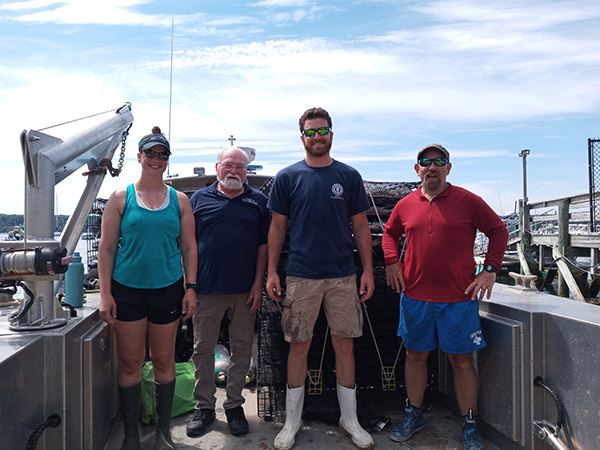Oysters Part of Plan to Improve Water Quality in Port Jeff Harbor
In a joint effort between the Town of Brookhaven and SUNY Stony Brook, 20,000 oysters were added to Port Jefferson Harbor to study the potential these shellfish have in removing nutrients to improve water quality.
Experts say that one oyster can filter up to 50 gallons of water every day and have become an important part of the strategy environmentalists employ to clean up Long Island’s waterways.

Stony Brook University student Lucy Donahue, Town of Brookhaven Department of Environmental Protection staff Craig Strong and Dwight Surgan, and School of Marine and Atmospheric Sciences Associate Professor Bradley Peterson stand in front of 10 bottom cages, each holding 10,000 oysters. Photo: Town of Brookhaven.
Suburban sprawl on Long Island has severely damaged the ecosystem polluting the bays of the South Shore to the point where surviving shellfish were filtering only 1 percent of the water, compared to 1976 when they filtered up to 40 percent. Other efforts on the south shore have resulted in the planting of over 1 million oysters in the Great South Bay.
Staff from the Town of Brookhaven Division of Environmental Protection, the School of Marine and Atmospheric Sciences and Stony Brook University, did the planting in Port Jefferson in two areas of Port Jefferson Harbor. According to a press release from Brookhaven Town, the program is funded by the Long Island Sound Futures Fund and the Town of Brookhaven.

Town workboat transporting 100,000 oysters from Mt Sinai Harbor shellfish facility to Port Jefferson Harbor. Transporting took two days due to the large number of cages and oysters. Photo: Town of Brookhaven.
Oysters are contained in mesh bags placed in bottom cages at a density of 1,000 oysters per mesh bag, 10 bags per cage. Every month, staff and students will take water samples and use water quality probes to record nitrogen, phosphorus, and other environmental data immediately adjacent to and 60 ft away from the oysters to measure their ability to improve water quality. The cages were placed in management areas where shellfishing is prohibited.
The study will run until November 2021.
